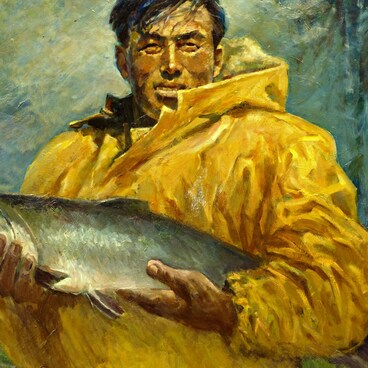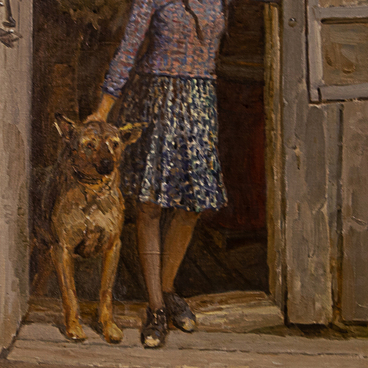The painter Boris Gerasimovich Shakhnazarov (1905–1993) was born in the Armenian (now Turkish) city of Kars. In 1918, Armenia was occupied by Turkey, and the family was forced to move to Georgia. There, in Tiflis (present-day Tbilisi), Boris Shakhnazarov began his artistic journey. He entered the studio headed by Professor Moisey Ivanovich Toidze and studied there from 1926 to 1928; in 1927, his paintings together with works of other fellow students were exhibited in Moscow.
In 1928–1930, Shakhnazarov studied at the Tiflis Academy of Arts; when it was closed, he continued his studies in Leningrad and then left for Stalinabad (present-day Dushanbe in Tajikistan) to teach at an art school. In 1941, he volunteered to go to the front; after being wounded, he got his teacher’s position back and lived in Stalinabad until the end of the war.
In 1946, Boris Shakhnazarov moved to Sakhalin. A southerner by birth, he was fascinated by northern nature and strove to convey this revelation to his viewers. The artist was not easily impressed by battle scenes or large-scale construction sites: the vast and varied nature — both by just itself and in unity with people — attracted him much more.
The pre-Sakhalin and Sakhalin periods of Shakhnazarov’s oeuvre are distinct for his smooth and deeply realistic manner of painting. In 1962, the artist was invited to work in Khabarovsk. This relocation influenced his manner of painting between the 1960s and the 1970s: it acquired the subtlety and sensibility of impressionists.
Boris Shakhnazarov liked to paint still lifes. As a former front-line soldier, he felt joyful and grateful for the peace and quiet of life without war and was able to convey his feelings in his works.
The composition of the still life “Dried Fish” is arranged in a certain way so that the viewer can explore each object in detail and feel their texture, weight, even their smell. The artist uses contrasts to draw attention to each of his “characters”: large and small (the clay pot and the quince), light and dark (the pot and the fish), round and flat (the quince and the towel), hard and soft, shiny and matt (the tabletop and the towel). The contrast between light and dark also helps to highlight certain details.
In 1984, Boris Shakhnazarov was given the title of Honored Artist of the RSFSR. He participated in district, regional, all-Union and national exhibitions. Nowadays, his paintings can be found in museums and art galleries in Komsomolsk-on-Amur, Yuzhno-Sakhalinsk and Khabarovsk.
In 1928–1930, Shakhnazarov studied at the Tiflis Academy of Arts; when it was closed, he continued his studies in Leningrad and then left for Stalinabad (present-day Dushanbe in Tajikistan) to teach at an art school. In 1941, he volunteered to go to the front; after being wounded, he got his teacher’s position back and lived in Stalinabad until the end of the war.
In 1946, Boris Shakhnazarov moved to Sakhalin. A southerner by birth, he was fascinated by northern nature and strove to convey this revelation to his viewers. The artist was not easily impressed by battle scenes or large-scale construction sites: the vast and varied nature — both by just itself and in unity with people — attracted him much more.
The pre-Sakhalin and Sakhalin periods of Shakhnazarov’s oeuvre are distinct for his smooth and deeply realistic manner of painting. In 1962, the artist was invited to work in Khabarovsk. This relocation influenced his manner of painting between the 1960s and the 1970s: it acquired the subtlety and sensibility of impressionists.
Boris Shakhnazarov liked to paint still lifes. As a former front-line soldier, he felt joyful and grateful for the peace and quiet of life without war and was able to convey his feelings in his works.
The composition of the still life “Dried Fish” is arranged in a certain way so that the viewer can explore each object in detail and feel their texture, weight, even their smell. The artist uses contrasts to draw attention to each of his “characters”: large and small (the clay pot and the quince), light and dark (the pot and the fish), round and flat (the quince and the towel), hard and soft, shiny and matt (the tabletop and the towel). The contrast between light and dark also helps to highlight certain details.
In 1984, Boris Shakhnazarov was given the title of Honored Artist of the RSFSR. He participated in district, regional, all-Union and national exhibitions. Nowadays, his paintings can be found in museums and art galleries in Komsomolsk-on-Amur, Yuzhno-Sakhalinsk and Khabarovsk.


